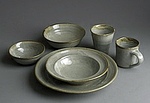Jane Herold: The More She Remains the Same, the More She Changes
I had ample opportunity to contemplate change as I climbed Ludlow Lane to Jane Herold’s place at the top of the hill. The first thing I noticed was how out of breath I was, nothing to do with getting on in years, you understand, just out of shape. And then of course the exquisite autumn weather and the particularly vibrant foliage this year gave me heart that perhaps my own autumn would be as brilliant, so when Jane’s pottery shed came into view looking exactly as it always has, I felt a deep reassurance that somewhere in this world, right here, in fact, there existed a sense of enduring.
You may have heard that recently Jane has been taking large orders from restaurants such as Aska, Betony, and The Clement in the Peninsula Hotel to make all of their dinnerware. Twelve hundred matching pieces each. This is obviously a good thing for her, and we would not want it any other way, but what will happen to the Jane we know and love? I sat down with her the other day and asked her this very question.
To begin and end with, Jane doesn’t make anything she doesn’t like. Restauranteurs cannot just order a thousand pots on-line; they must come out to Palisades and demonstrate to her that not only do they like her pots, they want them. They have to agree that her pots will add to the aesthetic experience of eating their food, be more appetizing than, as she puts it, eating out of something with as much character as a white toilet bowl. Her pots are desirable because they not only do not clash or compete with the food, they embrace it, offer it up as a gift to the diner. As a matter of principle, she turned down what would have been a lucrative order from a restaurant chain because their business need for a standard product clashed with her aesthetic vision.
Potting for major restaurants began when Fredrik Berselius, Executive Chef of Aska in Brooklyn, rode his bicycle into Piermont one day and stopped at Bunberry’s for refreshment. His drink was served in one of Jane’s mugs and he never forgot it. When it came time to open his own restaurant, a pop-up called Frej in the same space currently occupied by Aska, he asked Jane to throw his plates. From there, Bretony, a breakaway from Aska, placed another large order, and then the Clement after that. And now The Dutch reserves her plates for its VIPs.
In order to produce large orders on deadline, Jane has implemented some simple efficiencies. For example, she reorganized her drying racks to make it easier to match her pots to the client, and she hired someone to help her with the cutting and weighing of lumps of clay, carrying wood, and sifting ashes for use in glazes. The essential task she without exception reserves for herself, that is, throwing the pots.
A potter might understandably turn to elements of mass production to meet growing demand. The claim “hand made” can refer to as hands-off a task as manually activating a tool to press clay into a mould, a process known as jiggering and jollying. However, Jane continues to use her kick wheel and her hands to make each pot. She says this is how she keeps herself and her work alive, by staying true to her sense of scale and proportion. Far from stealing time and creative energy from her own work, Jane finds that working on large custom orders has enhanced her own potting by introducing new shapes for bowls, new lips for plates, even new pieces altogether. Jane has found an inspiring way to accommodate growth—the more she remains the same, the more she changes.
For more information about Jane Herold Pottery, go to JaneHerold.com.


